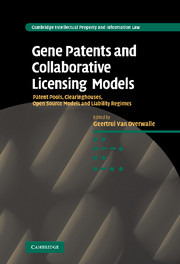 Gene Patents and Collaborative Licensing Models
Gene Patents and Collaborative Licensing Models Book contents
Preface
Published online by Cambridge University Press: 14 January 2010
Summary
At present the genetics community is increasingly concerned that patents might lead to restricted access to research and health care. Thoughtful observers are increasingly expressing concerns that the exponential growth of patents claiming human DNA sequences may lead to patent thickets, royalty stacking and, ultimately, to a ‘tragedy of the anticommons’ in the genomic field. An anticommons effect may also arise from blocking patents. Concerns have also been voiced with regard to downstream research as new genetic inventions might not find their way into products and a translational gap might emerge.
In an attempt to capture and comprehend these recent developments, and to reflect on potential remedies, the Centre for Intellectual Property Rights of the University Leuven (Belgium) organised a two-day international workshop on ‘Gene Patents and Clearing Models: From Concepts to Cases’ on 8–9 June 2006. This workshop took place in the framework of a research project on ‘Gene Patents and Public Health’ sponsored by the Fund for Scientific Research Flanders (FWO, Belgium – Grant number G.O120.04), EuroGenTest (a Network of Excellence set up under the European Union Framework Programme 6 – Contract number 512148) and the Vancraesbeeck Fund (K.U.Leuven, Belgium). For the research that led to the workshop and the present book, as well as for the workshop, we are very grateful to those organisations.
The workshop aimed at exploring models designed to render patented genetic inventions accessible to further use in research and to diagnosis and/or treatment in further depth, and to investigate alternative models.
- Type
- Chapter
- Information
- Gene Patents and Collaborative Licensing ModelsPatent Pools, Clearinghouses, Open Source Models and Liability Regimes, pp. xxiii - xxivPublisher: Cambridge University PressPrint publication year: 2009
- 5
- Cited by
